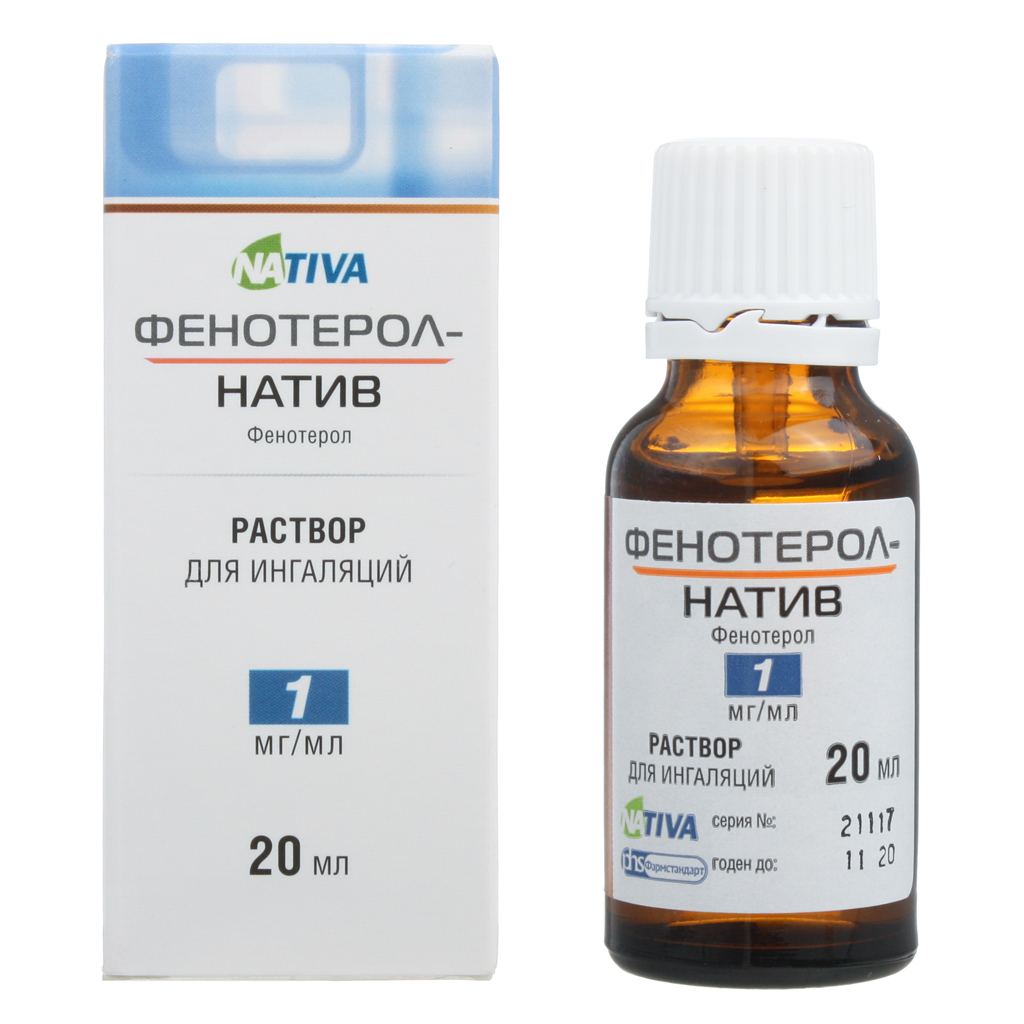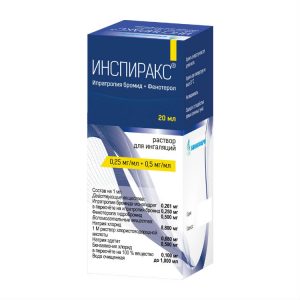Description
Release form
Inhalation solution is clear, colorless or with a slight yellowish tint.
Pharmacological action of
Bronchodilator beta2-adrenergic agonist
Pharmacological action of
Fenoterol native is an effective bronchodilator for the prevention and relief of bronchospasm attacks in bronchial asthma and other diseases accompanied by reversible obstruction of the respiratory tract, such as obstructive pulmonary obstruction, chronic bronchitis, emphysema.
Phenoterol is a selective stimulant of 2-adrenergic receptors. When using the drug in higher doses, β-adrenoreceptors are stimulated (for example, when prescribed for tocolytic therapy). The mechanism of action is associated with the activation of adenylate cyclase through a stimulatory Gs protein, followed by an increase in the formation of cyclic adenosine monophosphate (cAMP), which activates protein kinase A, the latter depriving myosin of the ability to bind to actin, which prevents the reduction of smooth muscle and contributes to bronchodilator action and elimination of bronchospasm.
In addition, phenoterol inhibits the release of inflammatory mediators from mast cells, thereby exerting a protective effect against the effects of bronchoconstrictors such as histamine, methacholine, cold air and allergens. The use of fenoterol in a dose of 0.6 mg increases the activity of ciliated epithelium of the bronchi and accelerates mucociliary transport.
Due to the stimulating effect on β-adrenergic receptors, phenoterol can have an effect on the myocardium (especially in doses exceeding therapeutic), causing increased heart rate and increased heart rate.
Fenoterol prevents and quickly stops bronchospasm of various origins. The onset of action after inhalation is 5 minutes, the maximum is 30-90 minutes, the duration is 3-5 hours.
Pharmacokinetics
Absorption
10-30% of the active substance released from the aerosol preparation after inhalation reaches the lower respiratory tract, depending on inhalation method and the inhalation system used, and the rest is deposited in the upper respiratory tract and swallowed. As a result, a certain amount of inhaled phenoterol enters the gastrointestinal tract. After inhalation of a single dose of the drug, the degree of absorption is 17% of the administered dose. Absorption is of a two-phase nature: 30% of phenoterol hydrobromide is rapidly absorbed with T1 / 2 for 11 minutes, 70% is absorbed slowly with T1 / 2 for 120 minutes. There is no correlation between plasma concentrations of phenoterol achieved after inhalation and the pharmacodynamic time-effect curve. The long-lasting (3-5 h) bronchodilating effect of the drug after inhalation, comparable with the corresponding effect achieved after iv administration, is not supported by high concentrations of the active substance in the systemic circulation.
Distribution of
Plasma Protein Binding – 40-55%. Unchanged, fenoterol can pass through the placental barrier and pass into breast milk.
Metabolism
When swallowed, the active substance undergoes biotransformation due to the effect of the first passage through the liver. Metabolized in the liver. Thus, the swallowed amount of the drug does not affect the concentration of the active substance in the blood plasma achieved after inhalation. Biotransformation of phenoterol in humans proceeds exclusively by conjugation with sulfates mainly in the intestinal wall.
Excretion
Excreted by the kidneys and with bile in the form of inactive sulfate conjugates. The excretion of phenoterol with urine (0.27 L / min) corresponds to approximately 15% of the average total clearance of a systemically available dose. The volume of renal clearance indicates tubular secretion of phenoterol in addition to glomerular filtration.
Indications
– asthma attacks or other conditions with reversible airway obstruction, such as chronic obstructive pulmonary disease, obstructive bronchitis, pulmonary emphysema
– prevention of asthma attacks due to physical stress
– as a bronchodilator before inhalation of other drugs (antibiotics, mucolytic drugs, corticosteroids)
– bronchodilation tests in the study of external respiration function.
Contraindications
– hypersensitivity to phenoterol or any component of the drug
– hypertrophic obstructive cardiomyopathy
– tachyarrhythmia
– under the age of 18 years.
Precautions: hyperthyroidism arterial hypotension arterial hypertension intestinal atony hypokalemia diabetes mellitus recent myocardial infarction (within the last 3 months) heart and vascular disease such as chronic heart failure, coronary artery disease, coronary artery disease, heart defects (including aortic stenosis) severe lesions of the cerebral and peripheral arteries pheochromocytoma glaucoma.
Use during pregnancy and lactation
No adverse effects on the course of pregnancy have been identified. Nevertheless, pregnant women (especially in the first trimester) are prescribed the drug only if the intended benefit to the mother outweighs the potential risk to the fetus. The possibility of the inhibitory effect of phenoterol on uterine contractility should be considered.
Fenoterol passes into breast milk. The safety of the drug during lactation has not been studied. The use of the drug during lactation is possible only in cases where the intended benefit to the mother outweighs the potential risk to the child.
Special instructions
Other sympathomimetic bronchodilators can be used simultaneously with Fenoterolum-native only under medical supervision.
In acute, rapidly increasing shortness of breath, the patient should consult a doctor immediately.
With prolonged use of the drug:
– stopping asthma attacks may be preferable to regular use of the drug (symptomatic treatment)
– regular examination of patients is necessary to identify the need for additional or more intensive anti-inflammatory treatment (for example, inhalation of corticosteroids) in order to control inflammation of the respiratory tract and prevent prolonged exacerbations of bronchial asthma.
In the case of increased bronchial obstruction, it is considered unacceptable and it may even be risky to increase the frequency of taking beta2-agonists contained in drugs such as Fenoterol native in excess of the recommended doses. In such a situation, the treatment plan and, especially, the adequacy of anti-inflammatory therapy should be reviewed.
In the treatment of beta2-agonists, the development of severe hypokalemia is possible. Particular care should be taken with severe bronchial asthma, as this effect can be enhanced by the concomitant use of xanthine derivatives, corticosteroids and diuretics. With hypoxia, an increase in the effect of hypokalemia on the heart rate is possible. In such situations, it is recommended to regularly monitor the concentration of potassium in the blood serum.
In rare cases, myocardial ischemia associated with beta2-agonists has been observed.
The use of phenoterol in patients with hypokalemia who receive cardiac glycosides can cause arrhythmia.
In patients with diabetes mellitus, regular monitoring of plasma glucose levels must be carried out during treatment.
The drug contains a stabilizer disodium edetate, which in some patients can cause bronchospasm.
The use of fenoterol can lead to positive results of tests for the abuse of psychoactive drugs for non-medical reasons, as well as for doping in athletes.
Influence on the ability to drive vehicles and control mechanisms
No studies have been conducted on the effect of the drug on the ability to drive vehicles and control mechanisms. In case of side effects, the use of the drug should refrain from driving vehicles and controlling machinery.
Composition
1 ml
phenoterol hydrobromide 1 mg
Excipients: sodium benzoate – 0.5 mg, disodium edetate dihydrate – 0.554 mg (corresponds to disodium edetate – 0.5 mg), citric acid monohydrate – 1.564 mg (citric acid) – 1.64 mg () water d / i – up to 1 ml.
Dosage and administration
The drug Fenoterol-native is intended only for inhalation.
20 drops = 1 ml.
1 drop = 50 ?g phenoterol hydrobromide.
Doses should be selected according to the individual needs of the patient, in addition, during treatment, the patient should be under the supervision of a doctor.
Attacks of bronchial asthma and other conditions accompanied by reversible airway obstruction
Inhalation. 0.5 ml (10 drops = 0.5 mg of fenoterol hydrobromide) in most cases is enough to immediately stop the attack.
If it is necessary to re-prescribe the drug, 0.5 ml (10 drops = 0.5 mg of fenoterol hydrobromide) is inhaled up to 4 times / day, however, an individual dose may be reduced depending on the effectiveness of the treatment.
In severe cases, if a dose of 1 ml (20 drops) is ineffective, higher doses of 1 to 1.25 ml (20-25 drops = 1-1.25 mg of fenoterol hydrobromide) may be required.
In extremely severe cases, if a dose of up to 2 ml (40 drops) is ineffective, 2 ml (40 drops = 2 mg of phenoterol hydrobromide) is inhaled under medical supervision.
Prevention of asthma attacks due to physical stress
Inhalation. 0.5 ml (10 drops = 0.5 mg of phenoterol hydrobromide) before exercise.
Treatment usually begins with the lowest recommended dose.
The recommended dose is diluted with 0.9% sodium chloride solution to a final volume of 3-4 ml, sprayed and inhaled until the resulting dilution is completely consumed.
Fenoterol-native should not be diluted with distilled water. The solution is diluted each time again before use. The remaining diluted solution is poured.
Fenoterol-native is recommended for use with an inhalation device – a nebulizer. In the presence of oxygen-breathing equipment, the solution is best inhaled at a flow rate of 6-8 l / min.
Fenoterol-native can be inhaled simultaneously with cholinergic and mucolytic agents. This applies, first of all, to ipratropium bromide and ambroxol preparations in the form of solutions for inhalation.
Side effects
Frequency determination: very often (> 1/10), often (from 1/100 to 1/10), infrequently (from 1/1000 to 1/100), rarely (from 1/10000 to 1 / 1000), very rarely (<1/10000). From the nervous system: very often – nervousness, anxiety, tremor, headache, dizziness is very rare – agitation. From the cardiovascular system: often – tachycardia, palpitations very rarely – arrhythmia, increased systolic blood pressure, decreased diastolic blood pressure, myocardial ischemia. From the side of metabolism and nutrition: often – hypokalemia, hyperglycemia. From the respiratory system: infrequently – coughing, irritation of the larynx and pharynx rarely – paradoxical bronchospasm. From the digestive system: infrequently – nausea, vomiting. On the part of the skin and subcutaneous tissues: infrequently – allergic skin reactions, such as rash, itching, urticaria, rarely – hyperhidrosis. From the musculoskeletal system: infrequently – muscle weakness, muscle spasm, myalgia. On the part of the immune system: rarely – hypersensitivity. Drug interaction corticosteroids, anticholinergics, xanthine derivatives (eg, theophylline), cromoglicic acid can enhance the effects of phenoterol. Beta-adrenergic drugs, corticosteroids and diuretics can enhance the side effects of fenoterol. Perhaps a significant decrease in the bronchodilatory effect of Fenoterol-native with the simultaneous administration of beta-blockers. Beta-agonists should be used with caution in patients receiving MAO inhibitors or tricyclic antidepressants, as these drugs are able to enhance the effects of fenoterol. Inhalation of halogenated hydrocarbon anesthetics (halotane, trichlorethylene, enflurane) can enhance the effect of phenoterol on the cardiovascular system. Halotan promotes the development of arrhythmias. The simultaneous administration of bronchodilators with a similar mechanism of action leads to an additive effect and overdose phenomena. Overdose Symptoms: tachycardia, increased heart rate, decreased or increased blood pressure, increased pulse pressure, chest pain, arrhythmias, sensation of hot flashes, tremor, metabolic acidosis, headache, dizziness, anxiety, agitation, hypokalemia. Treatment: sedatives, tranquilizers, in severe cases, carry out intensive symptomatic therapy. As specific antidotes, beta-blockers (preferably selective beta1-blockers) can be prescribed, it is necessary to take into account the possibility of increasing bronchial obstruction and carefully select the doses of these drugs in patients, suffering from bronchial asthma. Storage Conditions The product should be stored out of reach of children, protected from light at a temperature not exceeding 25 ° C. Do not freeze. The Expiration of is 3 years. Active ingredient Phenoterol Appointment of Adult on prescription Indications Asthma, Slow learner, bronchospasm Possible product names Fenoterol native solution for inhalation 1 mg / ml 20 ml 1pcs.




